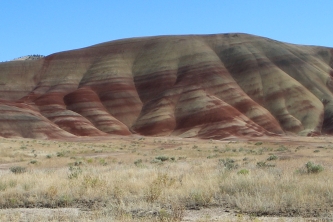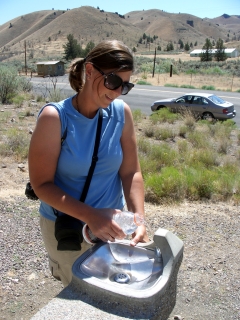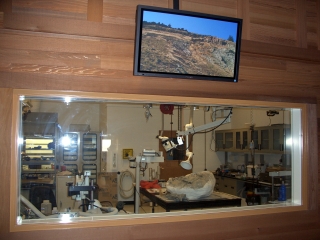NPS Website; Local Website
 WHAT IS IT?
WHAT IS IT?The John Day Fossil Beds contain six distinct and diverse successive ecologically climates whose fossilized remains represent over 40 million years of continuous life on Earth, almost the entire time that mammals have inhabited the planet.
BEAUTY (6/10)
Steep, jagged black rock cliffs created by volcanic mudflows, symmetrical mounds splashed with pink, red and orange horizontal stripes and ash pyramids surrounding by swaths of sagebrush and tall yellow native grasses currently make up the John Day Fossil Beds NM. The Park’s central and eastern Oregon landscape looks like nothing of this world. Greens are rare; are we really in the Emerald State?
It was not always this way. The area transformed from a tropical rain forest, 54 to 37 MYA (million years ago), to a deciduous forest, 39 to 18 MYA, then to a hardwood forest climate like the current eastern United States, 16 to 12 MYA and finally to a grassland savannah, 8 to 6 MYA.
HISTORICAL INTEREST (9/10)
The Park’s historically diverse climate accounts for a rich variation in mammalian remnants. The Age of Mammals, or the Cenozoic Era, began approximately 65 MYA and continues to this day. As time passed, the climates changed and the area’s fauna changed. Over millions of years, the area has seen crocodiles, giant browsers, saber-toothed cats, miniature horses, bear-dogs, elephants, antelopes, sloths and rhinos.
John Day Fossil Beds NM is unique among National Park fossil sites in that it covers the entire Cenozoic Era. Florissant Fossil Beds NM captures one instant in time, 35 MYA, Fossil Butte NM looks at a rainforest ecosystem from the early Cenozoic Era, Agate Fossil Beds NM examines a 23 MYA savannah and Hagerman Fossil Beds NM looks at 3.5 MYA horse fossils. John Day’s history includes everything found at these Sites and much, much more! (The Hagerman Horse is specific to Idaho but a substantial John Day Museum display traces the complicated evolutionary history of the horse).
CROWDS (6/10)
Not many people make it out to this part of Oregon.
 EASE OF USE/ACCESS (1/5)
EASE OF USE/ACCESS (1/5)The actual John Day Fossil Beds are spread throughout much of eastern Oregon. The Park Site protects only three small sections of these beds, the Clarno Unit, the Sheep Rock Unit and the Painted Hills Unit. These Units are a great distance from each other, a circuit visit will total over 120 miles. In addition, none of the Units is located particularly close to any population centers. Who knew Oregon included such a vast, desolate yellow landscape?
The Sheep Rock Unit contains the Park’s tremendous Visitor Center and Museum. It about 120 miles west of Interstate 5 at Baker City, Ore. via Oregon Route 7 and U.S. Route 26 or almost 150 miles southwest of I-5 at Pendleton, Ore. via U.S. Route 395 and U.S. Route 26.
Bend, Ore. is almost 115 miles to the east of the VC via U.S. Route 26. Portland is a distant 250 miles away.
CONCESSIONS/BOOKSTORE (2/5)
There are not a lot of books for sale. We are tempted at every fossil site by the wonderfully helpful, but expensive, Correlated History of the Earth poster. The only problem is: where would we put it?
COSTS (4/5)
The Sites and Museum are free. Gasoline is going to cost you.
RANGER/GUIDE TO TOURIST RATIO (3/5)
One terrific interpretive Ranger successfully juggled our questions, a Portland Oregonian newspaper photographer, a tourist conducting business on the Ranger desk phone and a decent flow of visitors. She was wonderful but could have benefited from some help.
TOURS/CLASSES (9/10)
The Thomas Condon Paleontology Center, located in the Park’s Sheep Rock Unit, has recently opened a new Museum. It had not opened yet when we visited but the Park’s Interpretive Ranger gave us a guided sneak peak of the then work in progress. She beamed like a proud parent while explaining the method behind the Museum’s displays.
She deserved to be proud. This compact but comprehensive Museum is one of the country’s best Paleontology museums. The displays begin at the start of the Age of Mammals and move chronologically to the present. John Day’s six ecological periods are represented by a murals depicting life at that time. At the base of the murals are actual fossilized remains from that period! These fossils are also painted somewhere in the mural for all you Where’s Waldo? fans.
The Museum’s set-up makes it easy to trace and understand difficult concepts: 65 million years of mammalian life, ecological change, extinction and rebirth. We regretted not being able to see the new Museum in its fully finished glory.
The Site’s tours and classes are not limited to the new Museum. The Paleontology Center includes in-depth displays on the hows and whys of the Paleontology profession. Glass partitions allow the visitor to look into the Site’s laboratory to see the mammal scientists hard at work. The James Cant Ranch, located across the street from the Center, delves into local homesteading history and recounts the initial 19th Century fossil discoveries. Self-guided loops are available at the Clarno and Painted Hills Units.
FUN (8/10)
Did we want to come to the John Day Fossil Beds NM? Not one bit. The Park’s isolation, high gas prices and high temperatures had us dreading the trip. We did not expect the incredible learning experience at the Paleontology Center or the stunning lunar landscape of the Painted Hills. We had a wonderful time even before the Ranger took us behind the heavy curtain and gave us a guided tour of the then not-yet-open Museum.
 WOULD WE RECOMMEND? (7/10)
WOULD WE RECOMMEND? (7/10)The Paleontology Center might be the best place in the United States to learn about the Age of Mammals; the Site has the fossils, the diversity, a great Ranger and a terrific museum, intelligent enough for parents and fun enough for kids.
Good luck in figuring out how to include this Site on either road trip or day trip plans. A detour stop if you are going from Boise, Idaho to Portland, Oregon might be do-able. The Park’s only drawback is its isolation.
TOTAL 55/80
www.usa-c2c.com
© 2005